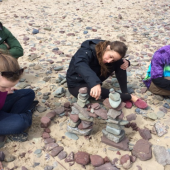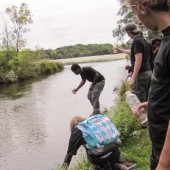
Environmental Study of Sustainable Places is a pedagogical experiment in multi-disciplinary curriculum development on several levels: 1) we integrated our multidisciplinary backgrounds in the social sciences and the humanities—political science and international relations with art and aesthetic education—to develop and co-teach these half courses; 2) student learning outcomes, course requirements, interactions and collaborations, multimedia texts (that can range from journal essays to Ted talks to articles from international press to images of environmental artists), and out of class projects, promote interdisciplinary learning; 3) the semester course confronts borders and boundaries of static college curriculum around sustainability as we examine global and local understanding of sustainability, which is a pre-requisite for a residency at the University of Wales Trinity Saint David where students crossed international borders and boundaries to conduct research of sustainable policy and enculturation in Wales, United Kingdom. Students attended interdisciplinary symposiums and work collaboratively with students representing different disciplines from the University of Wales; and 4) we delicately navigated the College’s curricula policy and bureaucracy to gain approval for a paradigm shift to use the concept of sustainability as a “pedagogical big idea” to assure that students would fulfill either of the Liberal Studies Curriculum requirements: Global Issues for Common Good or Artistic Experience.
Continue Reading
This case study describes an art-led environmental education project at an environmental charter high school in Minnesota. The project is a pilot of the model called Earth Systems Journey, and the theoretical approach of this model is summarized. Its goal is to provide experiential integration: a sense of self and place that are integrated with each other. The case study project, called “River Journey: Exploring the Value of the Mississippi River,” took place in the 2014-2015 school year with students in grades 9-12. River Journey takes students on a journey of their place in the local water cycle to discover how the water that flows through their school’s kitchen sink is interconnected, both upstream and downstream, to the Mississippi River through water and wastewater treatment and distribution infrastructure. Students create a GIS story map as a way to reflect on and integrate their learning and as a public educational resource. The idea of river exploration expands throughout the curriculum in the second half of the year, and another set of GIS story maps explore the river from the perspective of personal stories, population-water resource tensions, water as a strategic element in the Civil War, and ecological issues that occur along the length of the Mississippi River. Art and story inform the design of the journey and its dramatic props, including GIS, used throughout the experience.
Continue Reading